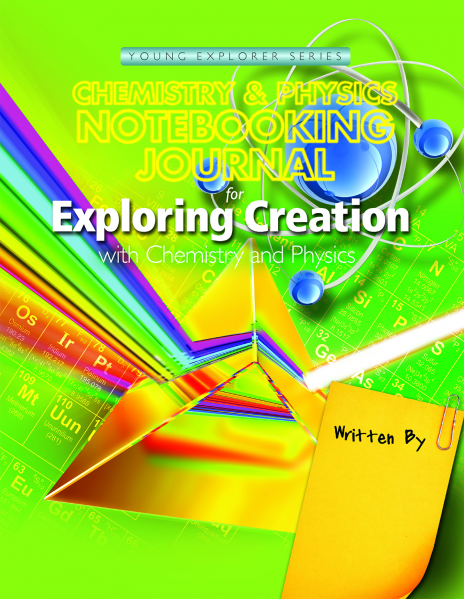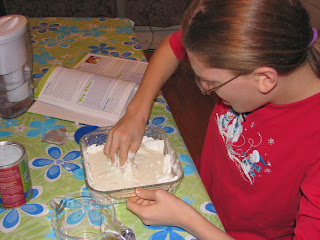
For the review, apologia sent us the Textbook ($39) and two Notebooking Journals ($24 each,) since both girls were going to be doing the experiments. Arlene is 13, so she was the primary target for the book. Emily is 15, so she was the 'extra hands' and sometimes the 'adult supervision' for the experiments. When someone is doing a science experiment around our house, whomever is home usually joins in. Both girls started out using the Notebooking Journals to record what they learned from the book, and to record some of their experiments. The hardcover textbook has over 250 pages of teaching, plus a supply list for each lesson, and an answer key in the back.


There are a total of 14 lessons in the book. The first 5 lessons focus on Chemistry, the others are about Physics. During the six weeks of the review, our girls managed to get through 4 lessons. I can see the book taking anywhere from a semester to two years to complete depending on how involved you get with each experiment. The Notebooking Journals have a sample schedule in the front that uses two days a week for 28 weeks to finish the book in one year.
Each Lesson has several (5-10) 'Try This' mini experiments as well as a Project or Experiment (or both) at the end of the lesson for review. I found that after a couple of weeks, the girls were so focused on doing all of the experiments that they forgot to use their journals. While I recommend the Junior Notebooking Journal for younger students, I encourage you to evaluate how much your older students are actually going to use their journal before you purchase one. (You can see sample pages on Apologia's website here.) With Arlene being at the upper age for this book, this is the one Apologia title I would probably not buy a journal for. Part of that is because Arlene eagerly shows and tells what she has learned...and she takes lots of pictures of the experiments (even if some of them ARE blurry.) On the other hand, if you're doing this title in preparation for Jr High or High School Chemistry or Physics, the completed journal would make a good reference book for your student to look back through.

During the lessons the girls were working on, they learned about matter, atoms, compounds, mixtures, and had an introduction to the Periodic Table of the Elements. I especially appreciated the section on the Periodic Table, as we never studied it until High School, but somehow our teachers thought we had learned about it in Middle School. It is introduced simply, but led to many discussions around our house, and a library book search, to learn more about it. That is one of the nice parts about the sample schedule only using 2 days a week...it leaves you time for rabbit trails! (For the review, Arlene worked on it 4 days a week.)
Once again, Jeannie Fulbright has written a quality science book that doesn't require a lot of expensive materials for the experiments. (Save those for High School!) Before the girls began, we went shopping for the supplies they would need for the first three lessons. Because of all the mixing and making, Jeannie recommends using measuring utensils that are NOT being used for food. We went to the dollar store, and a local big-box store and purchased all the supplies we didn't already have for just under $20. Quite reasonable for a Chemistry class. By looking at the other lessons, we will probably need to spend another $20-$25 for supplies to finish the book.
Because so much of understanding Chemistry and Physics comes from doing experiments, this is a very hands-on course. It is not necessary to do EVERY 'Try This,' but expect that your kids will want to do at least MOST of them! (I have found some families have recorded their experiments and placed them on YouTube.)
One excellent thing about this title from Apologia is that it can work well for many ages. So if you have a first grader, a third grader and a sixth grader, they can all do science together! I think this is helpful because most science books I have seen are not heavy on the experiment side until late elementary. Why not have your younger students join in? If your younger students aren't yet ready to learn about Chemistry (or you would like to do the experiments during nap time...) just remember to save the book a spot on your shelf and pull it out again in a few years. Adapt it to how it will work best for YOUR family!
This homeschool science resource would work well either at home or in a small co-op setting. This is hands-on learning, so a larger class might be difficult to manage...especially the cornstarch experiment! While Apologia has titles geared towards seventh and eighth grades, I would say that this title could qualify as Middle School work as well, IF you are having your student actively notebook or make lab sheets for their experiments. It is versatile.
Are you ready to learn about gears, magnets, levers and how Chemicals react? Great! Get the book! For those of you wondering if the book REALLY covers all the scientific stuff well...know that the content was reviewed by Dr. Jonathan Sarfati, Ph.D., F.M. from Creation Ministries International. And, like all the other Apologia titles, it points your students back to God the Creator and sustainer of the Universe!
Below I'll share some pictures from the girls' favorite experiments!
 |
| The cornstarch/ amorphous solid "Try This!' |
 |
| Arlene asked to add food coloring to her goo... |
 |
| The Solid Matter 'Try This!' |
 |
| Notice by day 2 that Arlene had eaten the frozen jello... |
 |
| Recording their findings...learning is more important than correct spelling! |
 |
| Getting ready for the Lava Lamps Experiment |
 |
| Four hands are better than two! |
 |
| Shake well |
 |
| Let's do it again...add more Alka-seltzer tablets |
 |
| Making Sorbet |
 |
| Finished! |
 |
| Taste Test. Dad said it can count for Science AND Home Ec! |













No comments:
Post a Comment